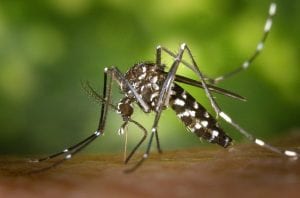Mosquitoes are among the most annoying pests in the world. However, in the United States, they are more of a nuisance than a health risk, as they may be in other parts of the world.
Fortunately, not all mosquitos transmit diseases. As vectors of disease-causing agents, they can be deadly. In the United States, we do not have the problem of mosquito-borne illnesses as many other countries experience. To most people, mosquitos are more of a nuisance in the United States, as they can turn a good summer activity into a painful experience.
Mosquitoes are vectors, or transmitters, of several viruses that can cause severe disease and even death in humans. In the United States, The West Nile Virus, St. Louis Encephalitis Virus, LaCrosse Encephalitis Virus, Eastern Equine Encephalitis Virus, and Western Equine Encephalitis Virus have caused illness and death.
There are about 60 different species of mosquitoes in Ohio, but only a dozen or more species are a public health concern. Aedes albopictus, the Asian tiger mosquito, and Ochlerotatus japonicus, the East Asian bush or rock pool mosquito, are two in particular.

Where do mosquitoes breed?
Mosquitoes breed in areas of standing water. Therefore, eliminating standing water is the most critical step in reducing and potentially eliminating mosquitoes in the area.
There are several places around the home where mosquitoes breed, many of which the homeowner may not be aware of. Some areas of concern:
Any standing water – puddles, stagnate ponds and creeks, tires, buckets, other containers.
Improperly maintained gutters – keep your gutters clean and free-flowing.
Catch basins that alternate between wet and dry.
Areas where floodwaters naturally collect, such as streams and stagnate ponds.
What do mosquitoes eat?
Adult male mosquitoes feed on honeydew, plant sap, and nectar. Females are attracted to warm-blooded animals, but some female species feed on honeydew, plant sap, and nectar. Purdue University states, “Female mosquitoes detect carbon dioxide emitted from warm-blooded animals over long distances. As a female flies upwind to a host, other cues play a role, including vision, moist air currents arising from a host, and specific odors emitted by a host.”
Some mosquito species feed nearby (about a quarter mile or so), while others have been known to feed several miles downwind from their habitats (See the Cleveland Clinic article, Mosquito Bites).
How do mosquitoes “bite”?
Male mosquitoes do not bite. Female mosquitoes, the blood-feeders, “bite” and suck blood for reproduction; they require the proteins from blood to produce eggs. They have a long mouth part called a proboscis, a long “needle” extending from their head. The proboscis pierces the skin, sucking blood, while injecting saliva into the bloodstream. Therefore, when a mosquito “bites,” it is piercing and sucking. That sucks.
When secreting saliva into the bloodstream, the “body registers the saliva as an allergen. Your immune system then sends the chemical histamine to the area where the mosquito bit you to remove the allergen from your body. Histamine is what causes your mosquito bites to itch and swell. Most people have a mosquito bite allergy” (See the Cleveland Clinic article, Mosquito Bites).
How do mosquitoes spread disease?
As a blood-sucking vector (a living thing that carries diseases between animals and humans; ticks and fleas are also blood-carrying vectors), mosquitoes carry infections through the blood they acquire. It transmits the disease when it secretes its saliva into the blood.
A female mosquito will feed on a person or an infected animal and passes the disease on when it bites. The female mosquito is also known as a sip-feeder, which means she acquires blood from multiple sources, which increases the likelihood of spreading infection.
What attracts mosquitoes to bite people?
Some people get bit by mosquitoes more than others. There are several reasons this may be the case. Wearing dark-colored clothing tends to attract more mosquitos than light-colored clothing. Wearing perfume can attract more as well. Emission of CO2, Blood type, and body temperature can also play a role in attracting mosquitoes as well.
Mosquito Facts:
- Only female mosquitoes bite.
- Mosquitoes typically lay eggs in standing water. Eliminating any sources of standing water around your home is an excellent start to reducing the population. Bird baths, buckets, water, and creeks that have standing water are all sources of breeding sites.
- Mosquitoes can detect carbon dioxide from 75 feet away. They are very sensitive to CO2, which attracts mosquitoes to humans.
- Mosquitoes are responsible for the deaths of more people than any other animal on the planet. Not sharks, lions, or Big Foot. Mosquitoes.
- One study showed that a full moon increases mosquito activity by nearly 500%.
Worldwide, there are over 3500 species of mosquitoes, 176 known species in the United States, and about 60 different species in Ohio. - “Mosquitoes find hosts by sight (they observe movement); by detecting infra-red radiation emitted by warm bodies; and by chemical signals (mosquitoes are attracted to carbon dioxide and lactic acid, among other chemicals) at distances of 25 to 35 meters” (www.mosquito.org/page/funfacts).
- The average lifespan of a mosquito is two months.
- Female mosquitoes lay up to 300 eggs, usually at night.
- Mosquitoes feed not only on humans but other animals such as birds and frogs.
